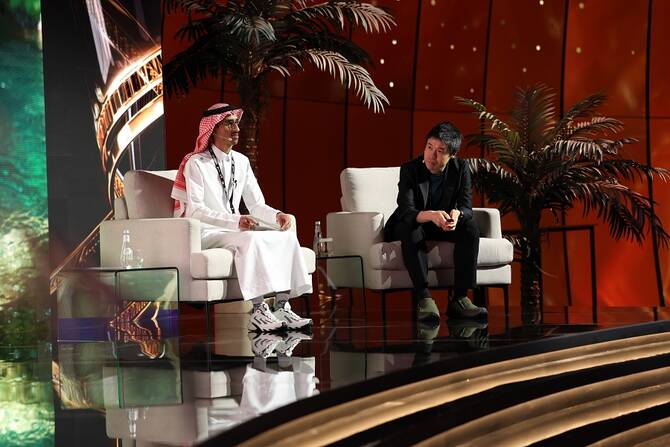In the world of filmmaking, few artists delve as deeply into the nuances of memory, myth, and nature as Japan’s Kaneko Masakazu. His recent appearance at the Saudi Film Festival has become a focal point for discussions on these themes. Kaneko’s work often blurs the lines between reality and imagination, crafting narratives that resonate with the audience’s own experiences and interpretations of the world.
By exploring the connection between memory and myth, Kaneko Masakazu invites viewers to reflect on how these elements shape their understanding of nature. His films often showcase lush landscapes that serve not just as backdrops, but as active participants in the storytelling, mirroring the inner landscapes of the characters. During his talk, Masakazu emphasized the importance of cultural context, highlighting how different societies interpret myth and its relationship to the natural world.
At the Saudi Film Festival, his insights were met with enthusiasm, particularly his unique approach to blending folklore with contemporary themes. This synthesis allows for a rich exploration of how nature influences memories and myths, creating a tapestry of storytelling that honors both tradition and innovation. As Kaneko Masakazu continues to push boundaries in his work, audiences are eager to see how he will further explore these themes in future projects.
Kaneko Masakazu’s Unique Approach At The Saudi Film Festival
At the recent Saudi Film Festival, renowned Japanese filmmaker Kaneko Masakazu showcased his distinctive approach that intertwines the realms of memory, myth, and nature. His films often reflect a deep appreciation for cultural narratives that resonate with global audiences, while simultaneously paying homage to his Japanese heritage. By leveraging these elements, Masakazu crafts cinematic experiences that are not only visually captivating but also emotionally profound, inviting viewers to reflect on their own memories and connections to nature.
Throughout the festival, Masakazu emphasized the role of cultural context in film creation and appreciation. He believes that understanding the myths inherent in various cultures adds layers of meaning to cinematic storytelling. By integrating themes of memory and myth, he challenges audiences to engage with his films on a deeper level, ultimately bridging cultural gaps and fostering appreciation for diverse storytelling techniques.
Moreover, Masakazu’s innovative filmmaking techniques were a focal point of discussion at the event. His unique approach to narrative structure often defies conventional filmmaking norms, encouraging viewers to navigate through implications of memory and myth in modern storytelling. As he continues to push the boundaries of cinema, his work serves as an important reminder of the profound connections between our collected memories, the myths that shape our cultures, and the nature that surrounds us.
The enthusiastic reception of his films at the Saudi Film Festival underscores the growing interest in international cinema and its ability to transcend borders. As Masakazu forges ahead with his artistic journey, his exploration of these key themes will likely inspire future discussions on the significance of cultural context in film, urging fellow filmmakers to consider the deeper implications of their creative choices.
Kaneko Masakazu‘s presentation and films at the Saudi Film Festival offer a rich tapestry of insights into filmmaking that resonate with audiences far and wide. His contribution to cinema serves not only as entertainment but also as an invitation to introspection and a deeper understanding of the narrative threads that connect us all.
The Role Of Cultural Context In Film Creation And Appreciation
Cultural context plays a crucial role in film creation and appreciation. Each film is not just a visual story but a reflection of the society and culture from which it emerges. This intersection between culture and cinema is vividly illustrated by the works of directors like Kaneko Masakazu, who skillfully integrates various cultural elements into his storytelling. When viewing films from different cultures, audiences often gain insights into unfamiliar traditions, values, and social dynamics, enriching their understanding of the world.
Kaneko Masakazu’s unique perspective, especially evident in the Saudi Film Festival, highlights how filmmakers utilize cultural references to evoke emotions and provoke thoughts. By exploring themes rooted in specific cultural experiences, films can resonate on a deeper level with audiences, leading to a more profound appreciation of the cinematic art form. This cultural context not only shapes the narrative but also influences audience perception, making it essential for filmmakers to consider their cultural foundations when crafting their stories.
Moreover, cultural context can also affect how films are received across different regions. For instance, some nuances may be lost in translation or misinterpreted if the audience lacks familiarity with the cultural backdrop. Therefore, understanding the cultural environment in which a film is made not only enhances the appreciation for the work but also fosters an empathy that transcends geographical boundaries.
As Kaneko Masakazu demonstrates through his work, the interplay of memory, myth, and nature within a cultural framework enriches the cinematic experience and fosters a greater appreciation for the diverse stories told through film. The Saudi Film Festival serves as a testament to this, offering a platform for such cultural dialogues through cinema.
Insights From Kaneko Masakazu: Filmmaking Techniques And Themes
Kaneko Masakazu’s work is a profound exploration of the intersection of memory and myth in cinema, offering audiences a unique perspective on the natural world. At the recent Saudi Film Festival, his films captivated viewers with their deep-rooted themes and intricate storytelling techniques. Masakazu believes that the essence of a film lies in its ability to evoke memories and create a sense of mythos around nature, grounding his narratives in the realities of human experience. His approach not only places emphasis on visual storytelling but also integrates sound and atmosphere, enhancing the audience’s connection to the subject matter.
During his insightful discussion at the Saudi Film Festival, Kaneko Masakazu elaborated on how he employs various filmmaking techniques to intertwine visuals with thematic depth. By utilizing symbolic imagery and resonant soundscapes, he constructs stories that resonate on both emotional and intellectual levels. This commitment to harnessing the power of memory and nature enab
Implications Of Memory And Myth In Modern Storytelling
In the realm of modern storytelling, the implications of memory and myth have become increasingly significant. These elements not only shape narratives but also influence how audiences perceive and connect with the stories being told. Memory serves as a personal and communal reservoir of experiences, allowing filmmakers to draw on their own histories and the histories of their cultures. Myths, on the other hand, provide a universal language through which stories can transcend cultural barriers, resonating with viewers from diverse backgrounds. By intertwining memory and myth, contemporary filmmakers create enriched narratives that invite deep reflection and foster a greater understanding of human experiences.
One shining example of this exploration is evident in the work of Kaneko Masakazu, who recently presented his insights at the Saudi Film Festival. His unique ability to weave together personal memories and cultural myths not only captivates his audience but also challenges them to reconsider their understanding of storytelling. Kaneko’s films often reflect the dichotomy between the mundane and the mystical, posing questions about the very nature of reality and perception. The festival provided a platform for this discourse, allowing attendees to engage with the profound implications of memory and mythology in cinema today.




